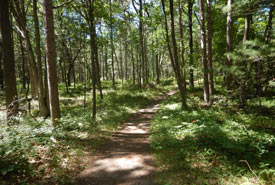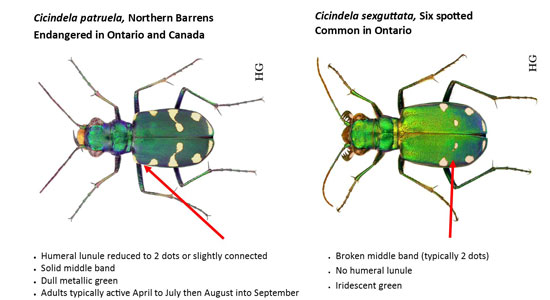The search for an endangered tiger beetle is on and you can help!

Northern barrens tiger beetle habitat (Photo by Sara McEwan, Ontario Parks)
I like plants. I have picked them, identified them, pressed them, documented them and eaten them. They are familiar and I look forward to seeing them every season. Insects, on the other hand, are not as familiar to me, but learning is always a good thing and insects are a very important part of nature’s biodiversity.
With the increase in available photography and insect resources, identification is easier than ever. Just like plants, some insects are challenging to identify and require technical keys and microscopes. But don’t be discouraged, there are many insects that are easier to identify, such as tiger beetles. There are 14 species of tiger beetles found in Ontario, with a couple more just over the border in Manitoba, New York and Quebec that could also be present in isolated border areas in Ontario.
The distinctive patterns on their wing coverings help make species of tiger beetle easy to distinguish from one another. Some, such as the ghost tiger beetle (Cicindela lepida), sport the perfect camouflage for their sandy habitat: a mottled white and light brown pattern. Other beetles have more mundane names, like the cow path tiger beetle (Cicindela purpurea), which can be found in numerous locations including, not surprisingly, on cow paths.
Northern barrens tiger beetle (Cicindela patruela) is an endangered species, both federally and provincially, and is found in just one southern Ontario location. Historically, it was found in many locations across Ontario, but despite searches of locations, the tiger beetle hasn’t been found. Recovery strategies have been completed for this species and with targeted searches and enhanced awareness of this species, more occurrences will be found.
Northern barrens tiger beetles prefer bare to sparsely vegetated, little-used dirt roads, trails, fire lanes, and transmission lines, on stable, partially compacted soils. Occasionally they are found at the edges of sand quarries or dunes, and in the United States they have been found along gravelly roads and in sandy areas with small pebbles and stones. The tree species dominating their habitat include oak and pine in savannahs and black oak and white pine, or jack pine and red oak in woodlands.
The northern barrens tiger beetle looks like one very common tiger beetle – the six-spotted beetle. The key identifying characteristics are shown in the images below.

Northern barrens tiger beetle vs six spotted tiger beetle (Photo by Henri Goulet)
Since the northern barrens tiger beetle has such small territories and don’t travel far, it is possible that more records of the species will be found. If you are walking along a pathway in one of the habitats noted, tiger beetles will fly and land along the trail ahead of you once you are within two to three metres. This pattern will continue until it flies around or over you and back to the trail. Binoculars are the best tool to get a good look ahead, without disturbing the tiger beetle. Simply scan the trail ahead for the beetle, and look for the markings noted in this blog.
What you can do
- Search for northern barrens tiger beetles, share information about the tiger beetles habitat, report your sightings to the Natural Heritage Information Centre.
- Do not harm the tiger beetle or modify their habitat.
- Help to protect tiger beetle habitat by supporting groups that secure and manage these special places, like the Nature Conservancy of Canada.


